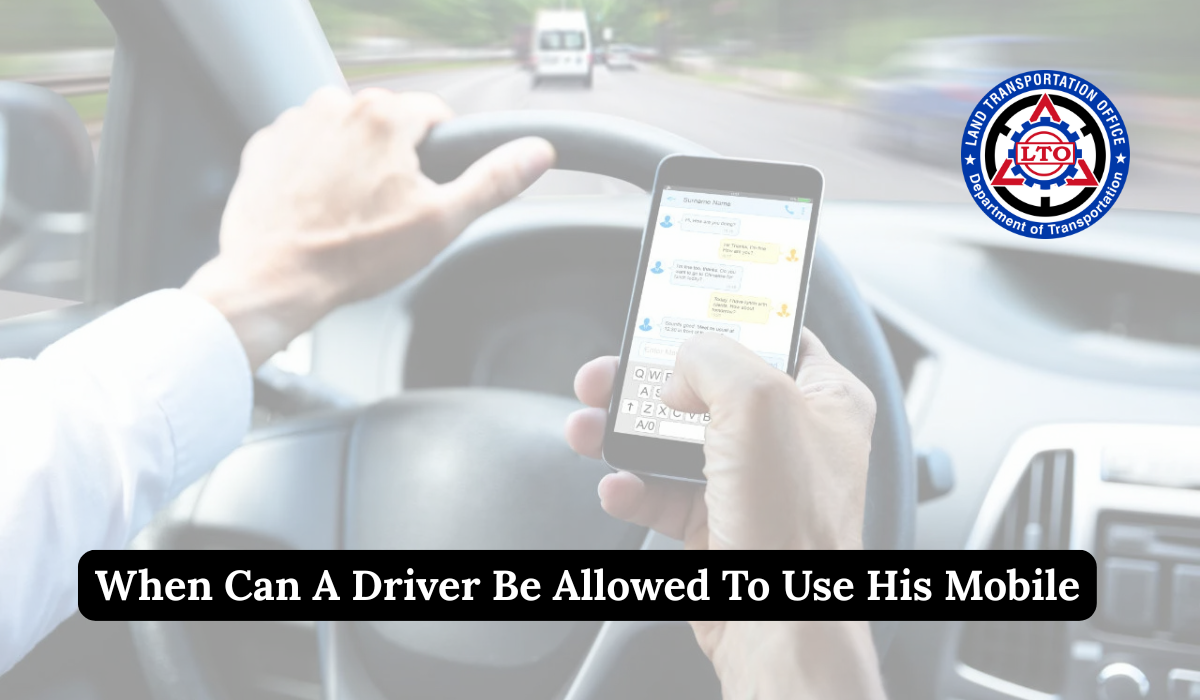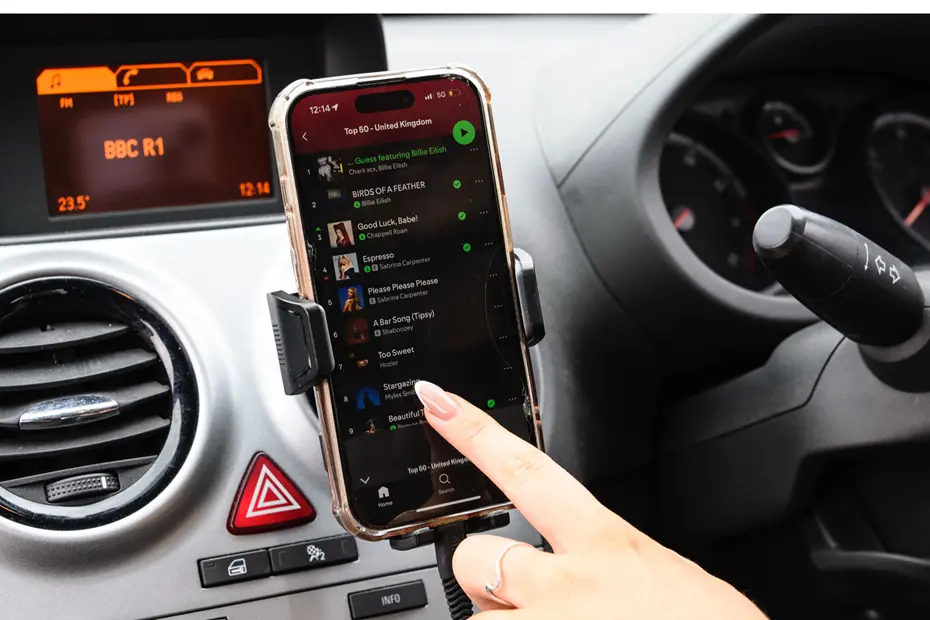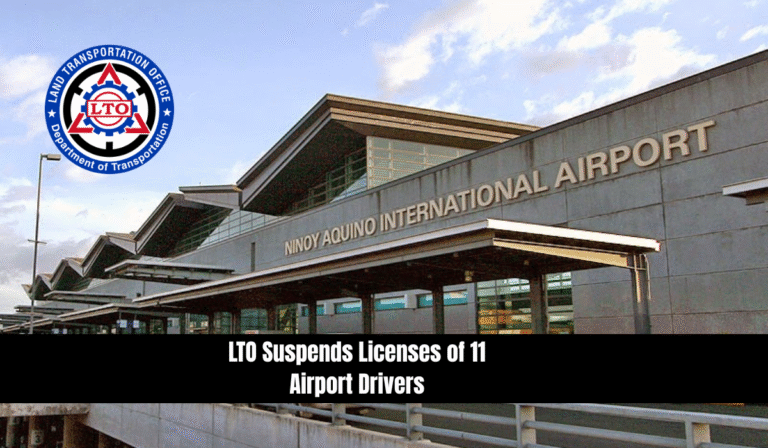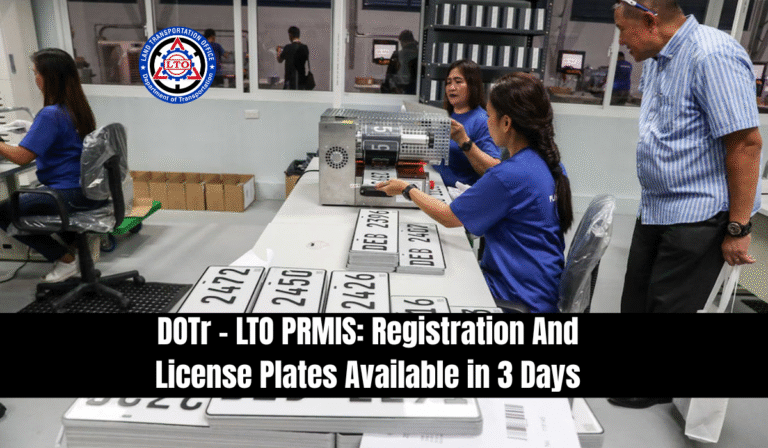When Can A Driver Be Allowed To Use His Mobile – LTMS Portal

When Can A Driver Be Allowed To Use His Mobile. In today’s digital world, almost everyone depends on mobile phones for communication, navigation, and daily tasks. However, when you’re behind the wheel, using a phone can be dangerous and even illegal.
In the Philippines, the use of mobile phones while driving is regulated under Republic Act No. 10913, also known as the Anti-Distracted Driving Act (ADDA). Enacted in 2017, this law aims to prevent road accidents caused by distracted driving one of the leading causes of injuries and fatalities on Philippine roads.
Let’s break this down in simple terms.
What is the Anti-Distracted Driving Act (RA 10913)?
The Anti-Distracted Driving Act (ADDA) was enacted in 2017 to reduce road accidents caused by distracted driving. It prohibits drivers from using electronic devices especially mobile phones while operating a vehicle.
The goal is simple: keep your hands on the wheel and your eyes on the road.
Under this law, you cannot:
- Text or call while driving
- Watch videos or movies
- Play games on your phone
- Browse the internet or social media
- Take selfies or record videos
- Read or compose messages or emails
However, there are certain exceptions where a driver is allowed to use a mobile phone legally. We’ll discuss those below.
Overview of the Mobile Landscape in the Philippines
Mobile phone use is woven into the daily life of Filipinos. It connects families, powers businesses, and keeps communities informed. Understanding this background helps explain why regulating phone use on the road was so important.
- Penetration and Ownership: The Philippines enjoys one of the highest mobile-phone penetration rates in Asia. Most Filipinos own at least one device, and smartphones are especially popular because they combine communication, entertainment, and productivity in a single gadget.
- Internet Connectivity: Affordable data plans have made mobile internet widely available. Millions go online every day to browse, chat, or check social media directly from their phones.
- Social Media Dominance; Platforms like Facebook, Instagram, and X (Twitter) dominate digital life. Filipinos spend hours online daily sometimes even while driving, which became a growing safety risk.
- Text Messaging Culture: Despite the rise of apps, SMS remains deeply rooted in Filipino communication. Quick text exchanges are still part of everyday habits.
- Mobile Banking and Transactions: Mobile wallets such as GCash and Maya transformed the way Filipinos handle money. People now pay bills, shop, and send remittances with just a few taps.
- Mobile Gaming Enthusiasm: Gaming on smartphones is booming. From casual titles to competitive esports, the accessibility of games increased screen time for everyone.
- Government Initiatives: The government continues to expand digital infrastructure and internet access to bridge the connectivity gap, especially in rural areas.
- Challenges: Some areas still suffer from weak signals and costly data. But connectivity keeps improving each year.
- Impact on SocietyPhones now influence education, healthcare, and business. They empower people but they also create risks when used irresponsibly, such as while driving.
Mobile Phones and the Anti-Distracted Driving Act (RA 10913)
Because phones became inseparable from modern life, accidents involving distracted drivers began to rise sharply. To address this, the Philippines enacted the Anti-Distracted Driving Act in 2017.
The law defines a mobile communication device as any handheld electronic gadget used for communication, entertainment, or processing information including smartphones and tablets.
What the Law Prohibits
Drivers are banned from:
- Holding or operating phones for calls or texts
- Playing games or watching videos
- Browsing the internet or reading messages
- Using entertainment apps while the vehicle is moving
Even when stopped at a red light, holding a phone is still considered distracted driving.
What the Law Allows
Drivers may use mobile devices only if:
- They operate in hands-free mode (e.g., Bluetooth or speakerphone), or
- They are calling authorities in an emergency (fire, crime, accident, or medical distress).
Why This Law Matters
Before RA 10913, distracted driving ranked among the top causes of road crashes nationwide. Each year, thousands of incidents were traced to texting or calling while driving.
This law was introduced to:
- Protect lives by reducing accidents
- Encourage discipline among motorists
- Balance connectivity and safety
It’s not about taking away convenience it’s about keeping everyone safe.
Is Using a Mobile Phone Illegal While Driving in the Philippines?
Yes: using a mobile phone while driving is illegal unless you follow specific exceptions outlined in RA 10913.
The Anti-Distracted Driving Act prohibits holding or operating any communication or electronic device while driving or even while temporarily stopped at traffic lights.
The only time it’s allowed is when you use hands-free technology or during emergency situations.

When Can a Driver Be Allowed to Use His Mobile Phone?
The law recognizes that there are times when mobile communication is necessary. That’s why RA 10913 includes exemptions that allow drivers to use their mobile phones safely and legally.
Here are the specific situations when it is allowed:
1. Using Hands-Free Devices
Drivers may use hands-free technology such as:
- Bluetooth headsets
- Speakerphones
- Microphones
- Built-in car audio systems
- Voice command systems (like Siri or Google Assistant)
- Allowed Example: You can take a call through your car’s Bluetooth system or earphones without holding the phone.
- Not Allowed: Holding your phone in your hand—even on speaker mode—while driving.
2. Using Mobile Phones for Navigation
You can use your phone for navigation (like Waze or Google Maps) if:
- The phone is mounted on a holder, dashboard, or windshield within safe viewing distance.
- It does not obstruct your line of sight (the law specifies that it should not be more than four inches above the dashboard).
- You set up the route before you start driving.
- Allowed Example: Your phone is mounted properly, and you’re following turn-by-turn voice directions.
- Not Allowed: Holding the phone in your hand to adjust the map while the vehicle is moving.
3. During Emergency Situations
The law allows the use of mobile phones to make emergency calls to authorities such as:
- Police
- Fire department
- Ambulance or emergency medical services
- Disaster response units
- Allowed Example: Calling the police to report an accident, crime, or fire.
- Not Allowed: Calling a friend to chat while driving.
4. When the Vehicle Is Safely Parked
If you are completely parked in a safe location, you can use your phone freely.
However, being stopped in traffic or at a red light does not count as parked.
- Allowed Example: You pulled over safely and turned on your hazard lights before using your phone.
- Not Allowed: Using your phone while waiting for the light to turn green.
Dangers of Using Mobile Phones While Driving
Using a mobile phone while driving in the Philippines is one of the leading causes of road accidents. It doesn’t just break traffic rules it puts your life, your passengers, and everyone on the road at risk. This is exactly why the Anti-Distracted Driving Act (RA 10913) was introduced to save lives by reducing distractions behind the wheel.
Here are the main dangers every driver should know:
1. Loss of Focus
Even a few seconds of looking at your phone can take your eyes off the road long enough to miss a car, pedestrian, or traffic sign.
Drivers who use phones while driving are proven to be more likely to cause accidents. Always remember: your full attention should stay on the road — not your screen.
2. Higher Chance of Accidents
Using a phone while driving increases the risk of collisions, especially rear-end and side-impact crashes.
Many serious and fatal accidents in the Philippines happen because of drivers texting or calling while driving. One small distraction can have life-changing consequences.
3. Slower Reaction Time
Driving safely requires focus and quick decision-making. When you use a phone, your brain divides its attention, which slows your reaction time. This makes it harder to brake, turn, or respond to sudden dangers in traffic.
4. Breaking the Law
Using a mobile phone while driving is not only unsafe but also illegal. The Anti-Distracted Driving Act sets clear penalties for violators — from ₱5,000 to ₱20,000 in fines, plus possible license suspension or revocation for repeat offenders.
So, when you drive, leave your phone aside — it’s not worth the risk.
5. Fatal Consequences
A two-second distraction might not seem serious, but at high speed, it can be deadly.
Most victims of distracted driving include pedestrians, cyclists, and motorbike riders who pay the price for another person’s carelessness. Staying alert means saving lives.
6. Texting: The Most Dangerous Distraction
Texting while driving is considered the worst form of distraction because it affects you in three ways:
- Eyes off the road
- Hands off the wheel
- Mind off driving
That’s why texting behind the wheel is one of the most punished offenses under RA 10913.
7. Public Safety Concerns
Frequent mobile use while driving increases the number of road accidents nationwide. This affects hospitals, traffic flow, and emergency services. Every driver who avoids using a phone helps build a safer driving culture in the Philippines.
8. Enforcement and Awareness
Even with strict laws, catching offenders isn’t always easy especially when phones are used below window level or in tinted vehicles. That’s why public education is essential. Awareness campaigns and responsible behavior can make a bigger difference than fines alone.
9. Using Technology Responsibly
Modern vehicles now come with Bluetooth, voice commands, and hands-free systems to help drivers stay connected safely. However, these should still be used with caution.
If you need to call or message someone urgently, the best choice is to pull over to a safe spot first.
Prohibited Actions Under the Anti-Distracted Driving Act
The following actions are strictly prohibited under RA 10913:
| Prohibited Action | Description |
|---|---|
| Texting or calling | Sending or reading text messages while driving |
| Playing games | Using mobile games or entertainment apps |
| Watching videos | Watching movies or streaming content |
| Taking photos/videos | Taking selfies or recording while driving |
| Using social media | Browsing Facebook, Instagram, or TikTok |
| Reading e-books or emails | Any reading activity using a device |
| Surfing the internet | Using browsers or chatting apps while on the road |
All these actions cause distraction and are punishable under the law.
Legal Penalties for Violations
The Land Transportation Office (LTO), Philippine National Police (PNP), and MMDA are responsible for enforcing this law.
If caught violating the Anti-Distracted Driving Act, here’s what you’ll face:
| Offense | Penalty | Additional Punishment |
|---|---|---|
| First Offense | ₱5,000 fine | — |
| Second Offense | ₱10,000 fine | — |
| Third Offense | ₱15,000 fine | 3-month driver’s license suspension |
| Fourth and Subsequent Offenses | ₱20,000 fine | Revocation of driver’s license |
Important: Once your license is revoked, you’ll have to reapply for a new one, which involves retaking the LTO exam.
Exemptions Under the Anti-Distracted Driving Act
The Anti-Distracted Driving Act (RA 10913) recognizes that there are special circumstances when using a mobile device while driving is necessary for safety, communication, or emergencies. These cases are considered legal exemptions, meaning the driver is not violating the law when the device is used responsibly.
1. Hands-Free or Similar Devices
Drivers may use mobile phones or other electronic devices if they are operated using hands-free features or comparable technologies, such as:
- Speakerphone
- Bluetooth headset or earphones
- In-car microphone system
- Dashboard or windshield mounts
As long as the device is used without being held and does not block the driver’s line of sight, it is considered legal.
2. Emergency Situations
A driver is allowed to use a mobile phone to place or respond to emergency calls to authorities in situations involving:
- Crimes or criminal activity
- Road accidents
- Bomb threats or terrorist alerts
- Fires or explosions
- Urgent medical emergencies
- Situations where the driver’s safety or security is compromised
In such cases, the law prioritizes saving lives and property over the restriction of mobile use.
3. Maintaining a Balance Between Connectivity and Safety
The Philippine government encourages the responsible use of technology while driving. The use of hands-free communication and navigation systems helps maintain the balance between staying connected and ensuring road safety.
This approach aligns with global traffic safety practices promoting technology that keeps drivers informed without diverting their attention from the road.
How Far From the Dashboard Can You Mount Your Phone?
According to the Department of Transportation (DOTr), your device must not be more than 4 inches above the dashboard and must not block your view of the road.
Your phone’s screen should be visible without requiring you to look away from the road for more than a moment.
Who Implements the Anti-Distracted Driving Act?
Enforcement is carried out by:
- Land Transportation Office (LTO)
- Metropolitan Manila Development Authority (MMDA)
- Philippine National Police – Highway Patrol Group (PNP-HPG)
- Local Government Units (LGUs)
Traffic enforcers can issue tickets if they see you holding or using a mobile phone while driving.
Common Questions in the LTO Exam About Mobile Phone Use
If you’re preparing for the LTO Driver’s License Exam, you’ll likely encounter questions related to the Anti-Distracted Driving Act.
Here are some examples:
| Question | Answer |
|---|---|
| Is using a mobile phone while driving illegal? | Yes. Unless you’re using a hands-free device. |
| How many inches from the dashboard can a phone be mounted? | Not more than 4 inches. |
| What law regulates the use of mobile phones while driving? | Republic Act No. 10913 – Anti-Distracted Driving Act. |
| What is the penalty for the 3rd offense? | ₱15,000 fine and 3-month license suspension. |
| Can you use your phone while stopped at a red light? | No. You’re still considered “driving.” |
Why Using a Mobile Phone While Driving Is Dangerous
- Divided Attention: Your brain can’t focus fully on two tasks at once. When texting or calling, your reaction time slows down.
- Increased Risk of Accidents: Even a 2-second glance at your screen can lead to collisions.
- Endangering Others: Distracted driving not only puts you at risk but also pedestrians and other motorists.
- Legal Consequences: Violating the law can lead to hefty fines or suspension of your license.
- Moral Responsibility: Being a responsible driver means valuing safety over convenience.
Technology and Safer Alternatives
The government encourages drivers to adopt hands-free technology to stay connected safely.
Some modern alternatives include:
- Bluetooth integration in cars
- Voice-activated assistants like Siri or Google Assistant
- Dashboard mounts for safe navigation
- Do Not Disturb While Driving mode on smartphones
Remember: These tools are meant to assist, not distract.
Enforcement Challenges and Public Awareness
Despite the clear rules, some drivers continue to violate the law. Enforcement remains a challenge due to limited manpower and the widespread use of tinted vehicles.
To counter this, agencies like the DOTr, MMDA, and LTO conduct information campaigns, signages, and roadside inspections to remind drivers of the dangers of distracted driving.
Public cooperation is vital after all, no amount of technology can replace common sense and discipline.
Tips for Drivers: Stay Safe and Obey the Law
- Mount your phone properly before driving
- Use voice commands for navigation
- Avoid using your phone at stoplights
- Pull over for important calls
- Use hands-free devices responsibly
- Keep your eyes on the road at all times
What’s Allowed vs. What’s Not
| Situation | Allowed? | Explanation |
|---|---|---|
| Calling with Bluetooth headset | Allowed | Hands-free use is legal |
| Texting while driving | Not Allowed | Distracts attention |
| Using Waze or Google Maps on a mounted phone | Allowed | As long as the phone doesn’t block view |
| Making an emergency call | Allowed | For crime, fire, or medical emergencies |
| Using phone while stopped at red light | Not Allowed | Still considered “driving” |
| Taking selfies while driving | Not Allowed | Dangerous and illegal |
| Using phone when parked safely | Allowed | When the car is completely stopped |
FAQs
Is it illegal to use my phone while driving in the Philippines?
Ans: Yes. Under the Anti-Distracted Driving Act (RA 10913), it’s illegal to use a mobile phone while driving unless it’s in hands-free mode.
What is the penalty for using a cellphone while driving?
Ans: Fines start at ₱5,000 for the first offense and go up to ₱20,000 and license revocation for repeated violations.
Can I use my phone for navigation while driving?
Ans: Yes, but it must be mounted properly and not obstruct your view. Set your destination before driving.
Can I text while stopped at a traffic light?
Ans: No. You are still considered “driving,” and it is illegal.
When can I legally use my phone while in a car?
Ans: When you are parked, using hands-free devices, or during a real emergency.
Conclusion
In the end, road safety always comes before convenience. Mobile phones may connect us to the world, but behind the wheel, they can disconnect us from reality in just a few seconds. The Anti-Distracted Driving Act (RA 10913) isn’t just another law it’s a reminder that every text, call, or notification can wait, but a human life cannot.






